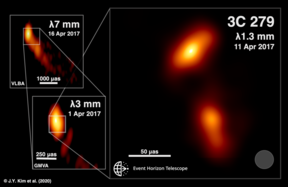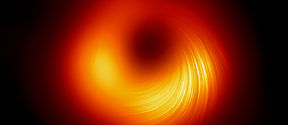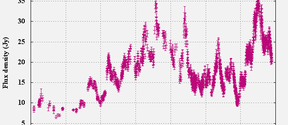Mustat aukot saattavat olla hyödyllisempiä kuin luulimmekaan
Jättimäiset avaruuden syöverit voivat repiä tähtiä kappaleiksi – mutta myös muovata kokonaisten galaksien kehitystä.

One year ago, the Event Horizon Telescope (EHT) Collaboration published the first image of a black hole in the nearby radio galaxy M 87. Now the collaboration has extracted new information from the EHT data on the distant quasar 3C 279: they observed the finest detail ever seen in a jet produced by a supermassive black hole. New analyses, led by Jae-Young Kim from the Max Planck Institute for Radio Astronomy (MPIfR) in Bonn, enabled the collaboration to trace the jet back to its launch point, close to where violently variable radiation from across the electromagnetic spectrum arises.
The results are published in the coming issue of “Astronomy & Astrophysics“ on April 7th, 2020.
The EHT collaboration continues extracting information from the groundbreaking data collected in its global campaign in April 2017. One target of the observations was a galaxy 5 billion light-years away in the constellation Virgo that scientists classify as a quasar because an ultra-luminous source of energy at its center shines and flickers as gas falls into a giant black hole. The target, 3C 279, contains a black hole about one billion times more massive than our Sun. Twin fire-hose-like jets of plasma erupt from the black hole and disk system at velocities close to the speed of light: a consequence of the enormous forces unleashed as matter descends into the black hole’s immense gravity.
To capture the new image, the EHT uses a technique called very long baseline interferometry (VLBI), which synchronizes and links radio dishes around the world. By combining this network to form one huge virtual Earth-size telescope, the EHT is able to resolve objects as small as 20 micro-arcseconds on the sky -- the equivalent of someone on Earth identifying an orange on the Moon. Data recorded at all the EHT sites around the world is transported to special supercomputers at MPIfR and at MIT’s Haystack Observatory, where they are combined. The combined data set is then carefully calibrated and analyzed by team of experts, which then enables EHT scientists to produce images with the finest detail possible from the surface of the Earth.
For 3C 279, the EHT can measure features finer than a light-year across, allowing astronomers to follow the jet down to the accretion disk and to see the jet and disk in action. The newly analyzed data show that the normally straight jet has an unexpected twisted shape at its base and, revealing features perpendicular to the jet that could be interpreted as the poles of the accretion disk where the jets are ejected. The fine details in the images change over consecutive days, possibly due to rotation of the accretion disk, and shredding and infall of material, phenomena expected from numerical simulations but never before observed.
Jae-Young Kim, researcher at MPIfR and lead author of the paper, is enthusiastic and at the same time puzzled: "We knew that every time you open a new window to the Universe you can find something new. Here, where we expected to find the region where the jet forms by going to the sharpest image possible, we find a kind of perpendicular structure. This is like finding a very different shape by opening the smallest Matryoshka doll."
Avery Broderick, an astrophysicist working at the Perimeter Institute, explains "For 3C 279, the combination of the transformative resolution of the EHT and new computational tools for interpreting its data have proved revelatory. What was a single radio 'core' is now resolved into two independent complexes. And they move -- even on scales as small as light-months, the jet in 3C 279 is speeding toward us at more than 99.5% of light speed!"
Because of this rapid motion, the jet in 3C 279 appears to move at about 20 times the speed of light. "This extraordinary optical illusion arises because the material is racing toward us, chasing down the very light it is emitting and making it appear to be moving faster than it is," clarifies Dom Pesce, a postdoctoral fellow at the Center for Astrophysics | Harvard & Smithsonian (CfA). The unexpected geometry suggests the presence of traveling shocks or instabilities in a bent, rotating jet, which might also explain emission at high energies such as gamma-rays.
Anton Zensus, Director at the MPIfR and Chair of the EHT Collaboration Board, stresses the achievement as a global effort: "Last year we could present the first image of the shadow of a black hole. Now we see unexpected changes in the shape of the jet in 3C 279, and we are not done yet. As we told last year: this is just the beginning."
"The EHT array is always improving," explains Shep Doeleman ot the CfA, EHT Founding Director. "These new quasar results demonstrate that the unique EHT capabilities can address a wide range of science questions, which will only grow as we continue to add new telescopes to the array. Our team is now working on a next-generation EHT array that will greatly sharpen the focus on black holes and allow us to make the first black hole movies."
Opportunities to conduct EHT observing campaigns occur once a year in early Northern springtime, but the March/April 2020 campaign had to be cancelled in response to the CoViD-19 global outbreak. In announcing the cancellation Michael Hecht, astronomer from the MIT/Haystack Observatory and EHT Deputy Project Director, concluded that: "We will now devote our full concentration to completion of scientific publications from the 2017 data and dive into the analysis of data obtained with the enhanced EHT array in 2018. We are looking forward to observations with the EHT array expanded to eleven observatories in the spring of 2021."
Original Paper: J.Y. Kim, T.P. Krichbaum, et al.: "Event Horizon Telescope imaging of the archetypal blazar 3C 279 at an extreme 20 microarcsecond resolution", in: Astronomy & Astrophysics (April 07, 2020)
Background Information:
The international collaboration announced the first-ever image of a black hole at the heart of the radio galaxy Messier 87 on April 10, 2019 by creating a virtual Earth-sized telescope. Supported by considerable international investment, the EHT links existing telescopes using novel systems -- creating a new instrument with the highest angular resolving power that has yet been achieved.
The individual telescopes involved in the EHT collaboration are: the Atacama Large Millimetre Telescope (ALMA), the Atacama Pathfinder EXplorer (APEX), the Greenland Telescope (since 2018), the IRAM 30-meter Telescope, the IRAM NOEMA Observatory (expected 2021), the Kitt Peak Telescope (expected 2021), the James Clerk Maxwell Telescope (JCMT), the Large Millimeter Telescope (LMT), the Submillimeter Array (SMA), the Submillimeter Telescope (SMT), and the South Pole Telescope (SPT).
The EHT consortium consists of 13 stakeholder institutes: the Academia Sinica Institute of Astronomy and Astrophysics, the University of Arizona, the University of Chicago, the East Asian Observatory, Goethe-Universität Frankfurt, Institut de Radioastronomie Millimétrique, Large Millimeter Telescope, Max-Planck-Institut für Radioastronomie, MIT Haystack Observatory, National Astronomical Observatory of Japan, Perimeter Institute for Theoretical Physics, Radboud University and the Smithsonian Astrophysical Observatory.

Jättimäiset avaruuden syöverit voivat repiä tähtiä kappaleiksi – mutta myös muovata kokonaisten galaksien kehitystä.

Uudet tulokset kertovat, mitä tapahtuu aivan mustan aukon reunalla, missä osa materiasta putoaa mustaan aukkoon ja osa suihkuaa valovuosien päähän.

Metsähovin havaintojen perustana ovat aktiivisten galaksien radiosäteilyn korkeiden radiotaajuuksien pitkäaikaiset valokäyrät. 37 gigahertsin valokäyriä löytyy monesta kohteesta jo neljältä vuosikymmeneltä.




